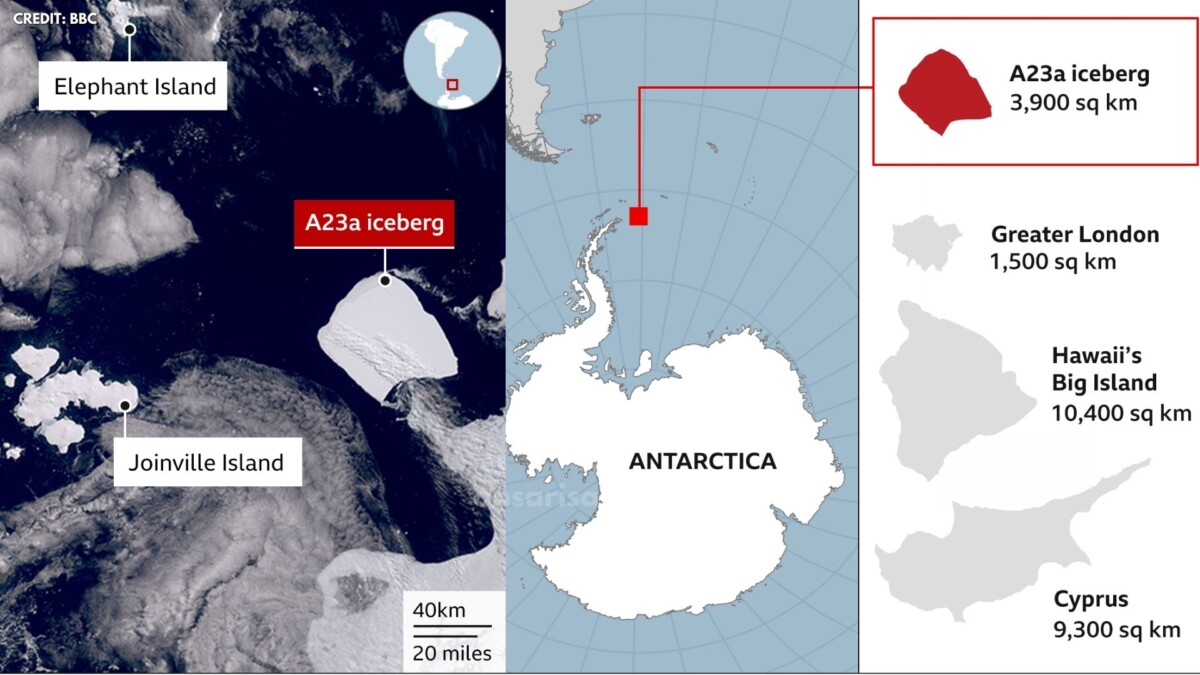
In a monumental event, Iceberg A23a, the world’s largest iceberg, recently embarked on a historic journey after being lodged near the Larsen C Ice Shelf in Antarctica for an astounding 37 years. This colossal ice giant, measuring an impressive 1,550 square kilometers (600 square miles), is now drifting towards South Georgia Island, leaving scientists, environmentalists, and the global community in awe. This blog delves into the captivating story of A23a, its journey, potential impacts on marine life and climate, and the broader implications of climate change on Antarctica.
A23a’s Remarkable Journey
A23a’s saga began in 1986 when it calved off from the Filchner Ice Shelf in Antarctica. For decades, it remained grounded near the Larsen C Ice Shelf, steadfast in its icy moorings. However, recent satellite imagery in late October and early November unveiled its detachment, marking the first significant movement in 37 years. The catalysts for this movement include ocean currents, winds, and the gradual melting of the Larsen C Ice Shelf, creating a pathway for A23a to break free.
Impacts on Marine Life and Climate
As A23a drifts towards the Southern Ocean, concerns arise regarding its potential impacts on marine life and climate. Given its colossal size, the iceberg could disrupt shipping lanes, pose hazards to fisheries, and alter ocean currents. Furthermore, the melting of icebergs contributes to rising sea levels, a dire consequence of climate change with far-reaching implications for coastal communities worldwide.
Scientists closely monitor A23a’s movement, anticipating its trajectory along the Antarctic Circumpolar Current, a powerful ocean current encircling the continent. While the iceberg’s ultimate fate remains uncertain, it is likely to break up and release massive amounts of freshwater into the Southern Ocean, influencing regional ecosystems.
Significance of A23a’s Movement
A23a’s unprecedented movement underscores the ongoing impact of climate change on Antarctica’s ice shelves and glaciers. The calving and drifting of such massive icebergs serve as tangible indicators of the region’s vulnerability to rising temperatures and changing ocean conditions. This event also emphasizes the interconnectedness of the Antarctic ecosystem, with changes in one area rippling through the Southern Ocean and beyond.
The Expedition to South Georgia Island
A23a’s trajectory towards South Georgia Island introduces new dimensions to the narrative. This remote British Overseas Territory in the Southern Ocean is home to diverse wildlife, including penguins, seals, and albatrosses. Scientists closely monitor the iceberg’s path, assessing potential risks to the island’s ecosystems and shipping traffic. The possibility of A23a grounding near the island raises concerns about its impact on wildlife and navigation.
Suggested: Breaking News: Earth Receives Laser-Beamed Message from 10 Million Miles Away
Addressing Climate Change Urgency
The movement of A23a serves as a stark reminder of the urgent need for continued research, monitoring, and global action to address climate change. The story of this colossal iceberg highlights the critical importance of understanding dynamic systems in Antarctica to predict future behaviors and mitigate the broader impacts of climate change on a global scale.
Conclusion
Epic journey of Iceberg A23a is a captivating tale that unravels the complexities of climate change in Antarctica. From its calving in 1986 to the recent drift towards South Georgia Island, A23a’s story encapsulates the fragility of our planet and the profound effects of human-induced climate change. As we witness the movement of this colossal iceberg, it is imperative that we acknowledge the urgency of addressing climate change, reducing greenhouse gas emissions, and safeguarding the delicate balance of our environment for generations to come.
Additional Information
Here is some additional information about A23a and climate change:
- A23a is the largest iceberg ever recorded to have drifted into the South Atlantic Ocean.
- Climate change is causing the Antarctic ice sheet to melt at an unprecedented rate.
- Rising sea levels are a major threat to coastal communities around the world.
- We must take action to reduce greenhouse gas emissions and mitigate the effects of climate change.








